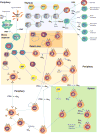Implications of non-canonical G-protein signaling for the immune system
- PMID: 24583286
- PMCID: PMC4116820
- DOI: 10.1016/j.cellsig.2014.02.010
Implications of non-canonical G-protein signaling for the immune system
Abstract
Heterotrimeric guanine nucleotide-binding proteins (G proteins), which consist of three subunits α, β, and γ, function as molecular switches to control downstream effector molecules activated by G protein-coupled receptors (GPCRs). The GTP/GDP binding status of Gα transmits information about the ligand binding state of the GPCR to intended signal transduction pathways. In immune cells heterotrimeric G proteins impact signal transduction pathways that directly, or indirectly, regulate cell migration, activation, survival, proliferation, and differentiation. The cells of the innate and adaptive immune system abundantly express chemoattractant receptors and lesser amounts of many other types of GPCRs. But heterotrimeric G-proteins not only function in classical GPCR signaling, but also in non-canonical signaling. In these pathways the guanine exchange factor (GEF) exerted by a GPCR in the canonical pathway is replaced or supplemented by another protein such as Ric-8A. In addition, other proteins such as AGS3-6 can compete with Gβγ for binding to GDP bound Gα. This competition can promote Gβγ signaling by freeing Gβγ from rapidly rebinding GDP bound Gα. The proteins that participate in these non-canonical signaling pathways will be briefly described and their role, or potential one, in cells of the immune system will be highlighted.
Keywords: G-protein signaling; Immune system; Non-canonical; Ric-8A.
Published by Elsevier Inc.
Figures

Similar articles
-
The GAPs, GEFs, and GDIs of heterotrimeric G-protein alpha subunits.Int J Biol Sci. 2005;1(2):51-66. doi: 10.7150/ijbs.1.51. Epub 2005 Apr 1. Int J Biol Sci. 2005. PMID: 15951850 Free PMC article. Review.
-
Mu Receptors.2024 Jun 8. In: StatPearls [Internet]. Treasure Island (FL): StatPearls Publishing; 2025 Jan–. 2024 Jun 8. In: StatPearls [Internet]. Treasure Island (FL): StatPearls Publishing; 2025 Jan–. PMID: 31855381 Free Books & Documents.
-
G-protein signaling: back to the future.Cell Mol Life Sci. 2005 Mar;62(5):551-77. doi: 10.1007/s00018-004-4462-3. Cell Mol Life Sci. 2005. PMID: 15747061 Free PMC article. Review.
-
Ric-8A catalyzes guanine nucleotide exchange on G alphai1 bound to the GPR/GoLoco exchange inhibitor AGS3.J Biol Chem. 2008 Aug 22;283(34):23150-60. doi: 10.1074/jbc.M802422200. Epub 2008 Jun 9. J Biol Chem. 2008. PMID: 18541531 Free PMC article.
-
Structure and function of heterotrimeric G protein-regulated Rho guanine nucleotide exchange factors.Mol Pharmacol. 2010 Feb;77(2):111-25. doi: 10.1124/mol.109.061234. Epub 2009 Oct 30. Mol Pharmacol. 2010. PMID: 19880753 Free PMC article. Review.
Cited by
-
Inhibition of Gαs/cAMP Signaling Decreases TCR-Stimulated IL-2 transcription in CD4(+) T Helper Cells.J Mol Signal. 2015 Jul 6;10:2. doi: 10.5334/1750-2187-10-2. J Mol Signal. 2015. PMID: 27096000 Free PMC article.
-
Pressure-Dependent Elevation of Vasoactive Intestinal Peptide Level in Chicken Choroid.Biology (Basel). 2023 Mar 24;12(4):495. doi: 10.3390/biology12040495. Biology (Basel). 2023. PMID: 37106696 Free PMC article.
-
Immunomodulatory Effects of Microbiota-Derived Short-Chain Fatty Acids in Autoimmune Liver Diseases.J Immunol. 2023 Jun 1;210(11):1629-1639. doi: 10.4049/jimmunol.2300016. J Immunol. 2023. PMID: 37186939 Free PMC article. Review.
-
GPCRs, G Proteins, and Their Impact on β-cell Function.Compr Physiol. 2020 Mar 12;10(2):453-490. doi: 10.1002/cphy.c190028. Compr Physiol. 2020. PMID: 32163203 Free PMC article. Review.
-
PAQR3 regulates Golgi vesicle fission and transport via the Gβγ-PKD signaling pathway.Cell Signal. 2015 Dec;27(12):2444-51. doi: 10.1016/j.cellsig.2015.08.017. Epub 2015 Aug 29. Cell Signal. 2015. PMID: 26327583 Free PMC article.
References
-
- Wang Y, Li Y, Shi G. Arch Immunol Ther Exp (Warsz) 2013;61(4):309–319. - PubMed
-
- Cho H, Kehrl JH. Prog Mol Biol Transl Sci. 2009;86:249–298. - PubMed
-
- Downes GB, Gautam N. Genomics. 1999;62(3):544–552. - PubMed
-
- Gales C, Rebois RV, Hogue M, Trieu P, Breit A, Hebert TE, Bouvier M. Nat Methods. 2005;2(3):177–184. - PubMed
-
- Paulssen RH, Woodson J, Liu Z, Ross EM. J Biol Chem. 1996;271(43):26622–26629. - PubMed
Publication types
MeSH terms
Substances
Grants and funding
LinkOut - more resources
Full Text Sources
Other Literature Sources

